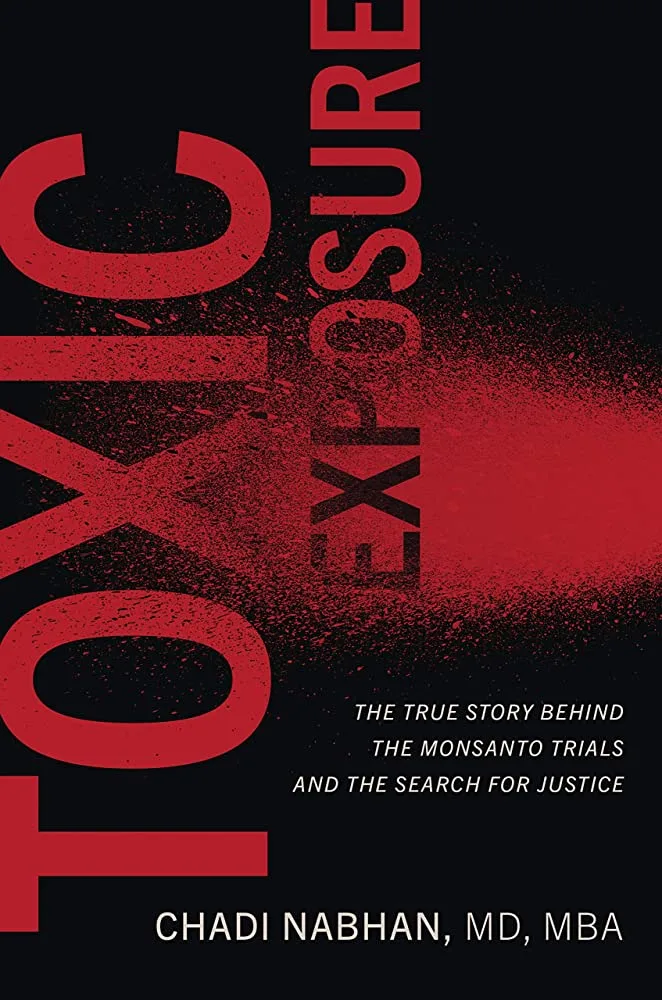It’s been nearly eight years since the filing of the first US lawsuit alleging that Roundup weed killer and other herbicides made by Monsanto with a chemical called glyphosate can cause non-Hodgkin lymphoma (NHL). Fueled by findings from international cancer scientists, the allegations sprawled into nationwide litigation that ultimately included more than 100,000 plaintiffs, and unveiled long-hidden corporate secrets.
After plaintiffs won the first three trials, Bayer AG, which bought Monsanto in 2018 as the first Roundup trial was getting underway, agreed to pay more than $11 billion to try to settle the litigation, and pledged to withdraw Roundup and other glyphosate-based products from the US consumer market. Though most plaintiffs have now settled, many opted out of the settlement, and trials around the US are continuing.
Chadi Nabhan, MD, MBA, a lymphoma specialist formerly with the University of Chicago, has been a key expert witness in many of the plaintiffs’ cases, including those who won the first three trials.
In his new book, Toxic Exposure: The True Story behind the Monsanto Trials and the Search for Justice, Nabhan gives readers a behind-the-scenes look into how he and other experts working for the plaintiffs’ lawyers pieced together a complicated scientific puzzle that convinced jurors of the company’s liability and the link between Roundup and NHL.
The book details what it was like for Nabhan to join the fight against Monsanto, explains how the trials affected his life’s trajectory, and highlights the struggles faced by plaintiffs suffering from cancer. The New Lede sat down with Nabhan to discuss the link between Roundup and NHL, his experiences at the trials, and what he thinks the public should know.
Q: Why was it important for you to share your experience with readers, and what do you hope they take away from your book?
A: When I went through these three trials, there was a lot of information that I learned through my own research, as well as through the legal proceedings, that I suspected the general public may not be aware of. I strongly feel that making people aware of the information about Roundup and its link to non-Hodgkin lymphoma is critical.
In February of 2019, I was being cross-examined by Monsanto’s attorney Brian Stekloff. And one of the things that he challenged me with was that I wasn’t going around the country and telling people about Roundup, its risks, and its association with cancer and lymphoma. And my answer was that I didn’t know that I could, since the trials were ongoing. He told me, in front of the judge, “No, actually, you can.” The minute he said that, I started thinking about the best way to share this information with the public. Writing a book to the general public seemed to be the best way to disseminate the information broadly.
My hope is to raise more awareness about the scientific link between Roundup and non-Hodgkin lymphoma. I hope readers really understand how I came to the conclusion that Roundup is not safe, and that patients need to be aware of the risks. I also hope that the general consumer does not take things at face value all the time. It’s okay to be a skeptic and ask questions. Monsanto always contended that if the Environmental Protection Agency (EPA) said glyphosate was safe, then it was safe. I think what the readers are going to notice is that just because the EPA said it’s safe, it doesn’t necessarily mean it’s safe. I really hope that this leads to more people asking critical questions, because ultimately, we all could be in the shoes of these patients.
Q: Since 1974, over 1.7 million tons of glyphosate-based weed killers were sprayed on fields, lawns, and gardens worldwide, making the potential human health impacts of Roundup and similar products enormous. Can you explain the link between Roundup and non-Hodgkin’s lymphoma? How did you arrive at the conclusions you did about that link?
A: Whenever you want to try to explore the causation and association between a compound and the development of cancer, such as non-Hodgkin lymphoma, you have to look at the totality of evidence. You cannot look at one piece of evidence and ignore another. So first, we look at mechanistic studies: Is there evidence out there that human cells, when they are exposed to glyphosate, develop damage to their DNA? Second, we look at animal studies. Are there animal studies to demonstrate that exposure to Roundup or glyphosate causes tumors or cancers in animals? Third, we look at epidemiologic studies. So, is there epidemiologic evidence that people exposed to glyphosate have a higher risk of developing cancer or non-Hodgkin lymphoma than people that are not exposed?
We have to put all of these types of research together to come to the conclusion that there is a link. Since the trials have concluded, there have been more papers that have shown the link between Roundup and the development of non-Hodgkin lymphoma. In fact, there was a paper published a few weeks ago that showed that the risk of developing non-Hodgkin lymphoma after glyphosate exposure is almost double that of people who have not been exposed. So, more evidence keeps coming out.
This does not mean that every person who sprays Roundup will develop non-Hodgkin lymphoma. And this does not mean that Roundup causes every case of non-Hodgkin lymphoma. So I think we have to be careful. But could Roundup cause non-Hodgkin lymphoma in some patients? Yes. That’s the main issue.
Q: What did the trials teach you about the US regulatory system, and whether it successfully protects the public?
A: Roundup was sold commercially for the first time in the United States and around the world in 1974, and at the time, the EPA was a very young agency. It did not have as many scientists, as many epidemiologists, or as many experts as it has now.
What we know from regulatory records is that some very early studies backed by Monsanto turned out to be fraudulent, and one very large study the company submitted to the EPA initially led EPA scientists to say glyphosate should be classified as possibly carcinogenic. But the EPA ultimately overturned the opinions of its scientists and agreed with Monsanto that glyphosate should be classified as not likely to be carcinogenic.
What has happened with Monsanto and Roundup should make us demand a higher level of scrutiny and rigor from the regulatory agencies. I was very disappointed with the EPA continuing to say that glyphosate is safe, and it was a claim that Monsanto always relied on. I’m very happy that the legal team and the jury were able to see through these arguments, but I worry a lot about something similar happening in the future.
Toxic Exposure: The True Story behind the Monsanto Trials and the Search for Justice is out now.
Republished with permission from The New Lede, by

The New Lede
The New Lede is a news initiative specializing in coverage of environmental issues that are critical to the health and well-being of people everywhere. We provide investigative reporting, analysis, and explanatory articles about a broad range of environmental topics that too often are ignored or underreported by mainstream media sources, filling that gap with vital information regarding the state of our air, water, food and climate.

